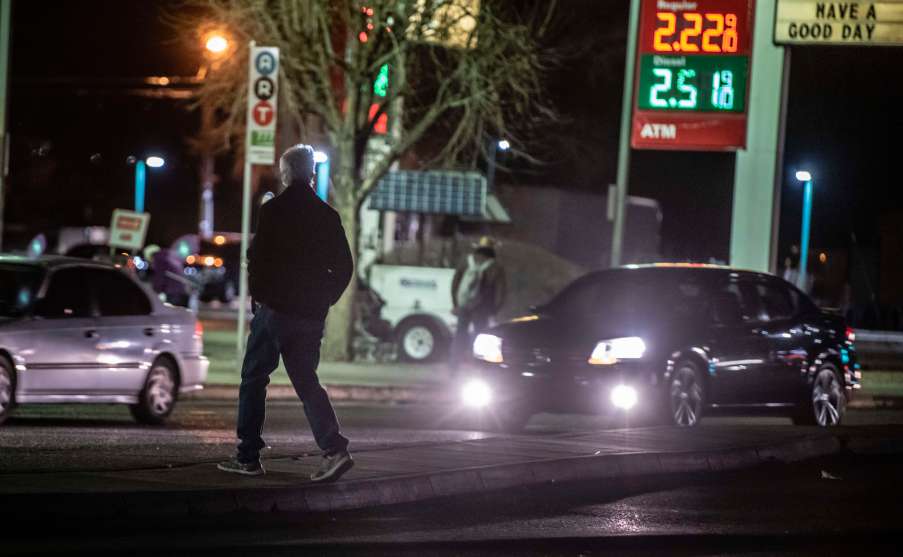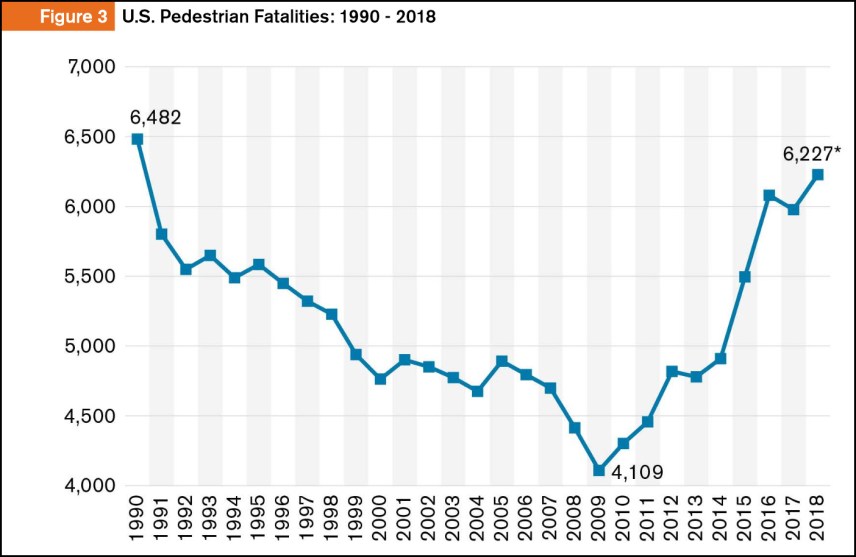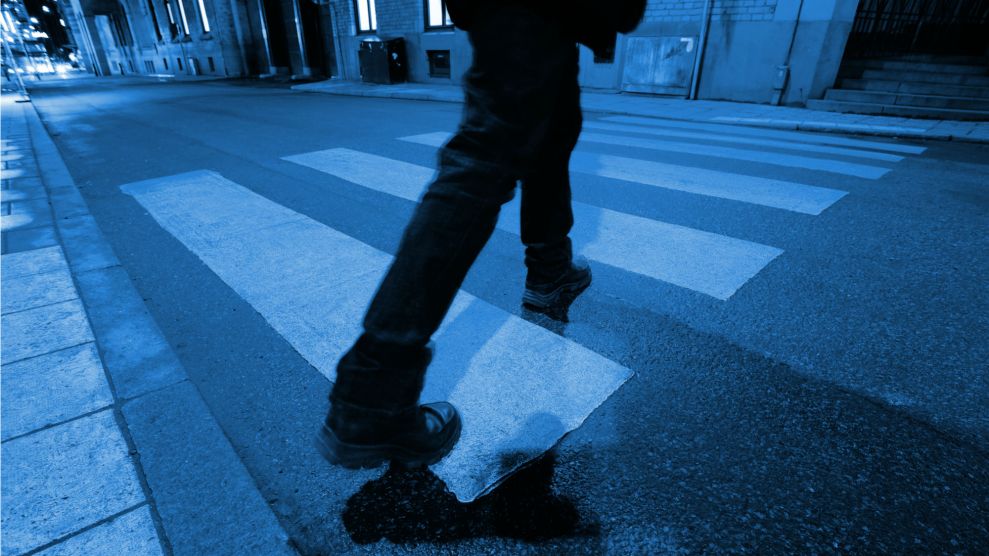
Roberto E. Rosales/Albuquerque Journal/Zuma
You don’t have to look far to find people who have been ticketed for jaywalking in American cities. Two of my colleagues eagerly shared their stories of being hit with fines during their morning commutes to Mother Jones’ offices. In 2012, when she was an assistant editor, investigations editor Hannah Levintova was fined $200 for “violating the walk signal” in San Francisco. Four years later, crack senior reporter Dan Friedman was jogging across the intersection of 16th and M Streets in Washington, DC, when a police officer ticketed him for violating a “Don’t Walk” signal. (In his defense, Dan insists that the light was yellow.)
If you regularly walk in any American city, you, too, probably have crossed a street against the signal or outside of a designated crosswalk. Sure, one could argue that crosswalks were created as a way to protect pedestrians from potentially dangerous automobiles. But why would transgressing those limits become a petty crime? Thanks to a century-old automobile industry campaign to push pedestrians out of the streets, jaywalking is now, in most places, punishable by a hefty ticket ranging from $68 in Seattle to as much as $250 in New York City.
This could be consigned to the realm of being merely annoying, but in fact, there’s a serious injustice embedded in the process. According to research in several cities, policing pedestrian behavior disproportionately affects low-income people and people of color. Plus, making jaywalking an offense doesn’t keep people safe. Now, a growing number of cities and states are striking these antiquated statutes from their books.
In September, the governor of California—whose biggest city, Los Angeles, is notorious for doling out jaywalking tickets—signed a law putting an end to the practice of ticketing jaywalkers. Last month, a bill to repeal jaywalking laws was introduced in Washington state. And last week, the Denver City Council voted to decriminalize jaywalking in Colorado’s capital.
The notion that pedestrians should be relegated to sidewalks and allowed to cross the street only when a walk sign tells them it’s safe is a relatively new phenomenon. As Peter Norton, an associate professor of history in the Department of Engineering and Society at the University of Virginia, wrote in his 2007 article “Street Rivals: Jaywalking and the Invention of the Motor Age Street,” groups ranging from the Chicago Motor Club and the Automobile Club of Southern California to the National Safety Council and the Boy Scouts began using the word “jaywalker” in the late 1910s and early 1920s to insult pedestrians who had the audacity to enter the roadway outside of intersections. The then-common prefix “jay-,” which meant “hick” or “rube,” implied that people who did such a thing were ignorant countryfolk who didn’t know how to act in a city. As cars increasingly gained dominance, Los Angeles passed the first anti-jaywalking ordinance in 1925, which became a model for other cities across the country. Discrimination soon followed.
“Even long before the automobile, there’s a history of laws that were written without ever mentioning race, but which empowered authorities to exercise a kind of racial enforcement,” Norton explains, citing vagrancy laws in the period after the Civil War as an example. “Jaywalking is that kind [of law] in the sense that basically everybody who walks anywhere ends up at some point crossing a street in a convenient way.”
Now, data from cities across the country show that Black people are routinely cited for jaywalking at higher rates than white people, making their simple act of crossing the street grounds for potentially dangerous police interactions. In 2017, a sweeping investigation by ProPublica and the Florida Times-Union (republished with permission on Mother Jones) found that Black people received 55 percent of pedestrian tickets in Jacksonville, despite comprising just 29 percent of the city’s population. Those tickets were also overwhelmingly focused on residents of poor neighborhoods.
The Jacksonville sheriff’s office admitted that enforcement of rules against crossing on a yellow light, crossing outside the crosswalk, or “failing to cross a street at a right angle” were often an excuse to “stop suspicious people and question them for guns and or drugs.” Critics of jaywalking laws say that that’s part of the problem. Ethan Campbell, a research partner of the Transportation Choices Coalition, a nonprofit advocacy group in Washington state, compares anti-jaywalking laws to bicycle helmet requirements in that they offered a pretense for law enforcement to selectively police people in a “stop-and-frisk style approach.”
Campbell has been examining dispatch logs and police reports of all sorts of jaywalking stops in Washington state, including those that resulted in warnings rather than citations. He says that he was aware of dozens of jaywalking stops that resulted in the use of force by police officers. “We know that every police contact resulting from a jaywalking stop is potentially putting someone’s life in danger,” he says.
Jaywalking laws also explicitly target “a large fraction of the population” who can’t afford a car, Norton says. “Given that fact, any jaywalking law that’s enforced is already privileging the relatively well-off class.” In addition to punishing economically vulnerable people with fines, jaywalking laws encourage car ownership, whose upfront, insurance, and maintenance costs can further impoverish people already living on limited incomes, Norton says.
Nor would the repeal of jaywalking laws give pedestrians carte blanche to dart into the street. California Gov. Gavin Newson vetoed an initial version of the state’s “Free to Walk Act,” and signed it only once it stipulated that pedestrians could jaywalk when it was safe to do so. Campbell thinks that decriminalizing jaywalking is unlikely to change pedestrian behavior and notes that people have continued to wear bike helmets in Washington even after his county repealed its law requiring them.
Instead of relying on jaywalking laws to keep pedestrians safe, advocates argue for changes to road design. The neighborhoods where police frequently target jaywalkers are often characterized by “pedestrian-hostile infrastructure,” Campbell notes, with long distances between crosswalks and traffic signals that prioritize cars. He adds that a number of other options exist, from narrower streets and speed bumps to slow cars down, to curb extensions to reduce crossing distance, and refuge islands and flashing beacons to make street crossing safer. Norton suggests relaxing zoning rules so that community destinations like grocery stores can be accessible on foot to people in residential neighborhoods.
While Norton acknowledges that the latest legislative changes alone will not end car culture, and that most people in the country are not sympathetic to people walking outside of crosswalks, he’s heartened by the trend of overturning jaywalking laws. “The trend had been going the other way for so long,” he says, “that I feared that people had forgotten that walking is normal.”











